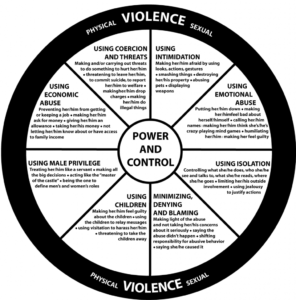 Domestic violence is a pattern of abusive behavior in a relationship that is used by one partner to gain or maintain power and control over another intimate partner. Domestic violence can take the form of physical, sexual, emotional, economic, or psychological actions or threats of actions that influence another person. This includes any behaviors that intimidate, manipulate, humiliate, isolate, frighten, terrorize, coerce, threaten, blame, hurt, injure, or wound someone.
Domestic violence is a pattern of abusive behavior in a relationship that is used by one partner to gain or maintain power and control over another intimate partner. Domestic violence can take the form of physical, sexual, emotional, economic, or psychological actions or threats of actions that influence another person. This includes any behaviors that intimidate, manipulate, humiliate, isolate, frighten, terrorize, coerce, threaten, blame, hurt, injure, or wound someone.
Domestic violence can happen to anyone regardless of race, age, sexual orientation, religion, or gender. Domestic violence affects people of all socioeconomic backgrounds and education levels. Domestic violence occurs in both opposite-sex and same-sex relationships and can happen to intimate partners who are married, living together, or dating.
Domestic violence not only affects those who are abused, but also has a substantial effect on family members, friends, co-workers, other witnesses, and the community at large. Children who grow up witnessing domestic violence are seriously affected by this crime. Frequent exposure to violence in the home not only predisposes children to numerous social and physical problems, but also teaches them that violence is a normal way of life. These experiences also increase their risk of becoming society’s next generation of victims and abusers.
There are many kinds of abuse. Below are descriptions of the most common types of abuse.
Physical
Physical abuse is hitting, slapping, shoving, grabbing, pinching, biting, hair pulling, etc. This type of abuse also includes denying a partner medical care or forcing alcohol and/or drug use upon him or her.
Sexual
Sexual abuse is coercing or attempting to coerce any sexual contact or behavior without consent. Sexual abuse includes, but is not limited to marital rape, attacks on sexual parts of the body, forcing sex after physical violence has occurred, or treating one in a sexually demeaning manner.
Emotional
Emotional abuse is undermining an individual’s sense of self-worth and/or self-esteem. This may include, but is not limited to constant criticism, diminishing one’s abilities or accomplishments, name-calling, or damaging one’s relationship with his or her children.
Economic
Economic abuse is defined as making or attempting to make an individual financially dependent by maintaining total control over financial resources, withholding one’s access to money, or forbidding one’s attendance at school or employment.
Psychological abuse causes fear through intimidation. Examples of this are threatening physical harm to themselves, their partner, children, or their partner’s family or friends, destruction of pets or property, and forcing isolation from family, friends, or school and/or work.
Another form of psychological abuse is termed gas-lighting, a method of mental abuse whereby the abuser manipulates information in order to make their partner doubt their sanity, memory, and/or perception of reality. For example, an abuser may deny that abuse has ever occurred and leads their partner into mistrusting their own memory and labeling him or her as “crazy”.
These descriptions were developed from definitions published by the United States Department of Justice Office on Violence Against Women (found here). Visit their home page here.


